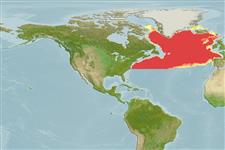Environment: milieu / climate zone / depth range / distribution range
Ecology
Marine; bathypelagic; depth range 216 - 3237 m (Ref. 58018). Deep-water; 70°N - 35°N, 75°W - 2°W
Eastern Atlantic: Iceland, Faeroes and Shetlands to Portugal. Probably antitropical and present in other oceans. Northwest Atlantic: Canada (Ref. 5951).
Size / Weight / Age
Maturity: Lm ? range ? - ? cm
Max length : 20.0 cm TL male/unsexed; (Ref. 123983)
Dorsal soft rays (total): 9 - 11; Anal soft rays: 16 - 19. Body robust and compressed. Small gill opening. Anal fin base longer than the length of the caudal peduncle. Dark pigment on the scale pockets (Ref. 37473).
Bathypelagic (Ref. 58426). Sometimes caught in large aggregations. Eggs and larvae are pelagic (Ref. 6345). Feeds on small crustaceans (Ref. 5951). Minimum depth reported taken from Ref. 117245.
Life cycle and mating behavior
Maturity | Reproduction | Spawning | Eggs | Fecundity | Larvae
Cohen, D.M., 1984. Bathylagidae. p. 392-394. In P.J.P. Whitehead, M.-L. Bauchot, J.-C. Hureau, J. Nielsen and E. Tortonese (eds.) Fishes of the north-eastern Atlantic and the Mediterranean, Volume 1. Unesco, Paris. (Ref. 6345)
IUCN Red List Status (Ref. 130435: Version 2024-1)
Threat to humans
Harmless
Human uses
Tools
Special reports
Download XML
Internet sources
Estimates based on models
Preferred temperature (Ref.
123201): 3.3 - 5.8, mean 3.9 °C (based on 372 cells).
Phylogenetic diversity index (Ref.
82804): PD
50 = 0.5078 [Uniqueness, from 0.5 = low to 2.0 = high].
Bayesian length-weight: a=0.00525 (0.00219 - 0.01260), b=3.01 (2.80 - 3.22), in cm total length, based on LWR estimates for this (Sub)family-body shape (Ref.
93245).
Trophic level (Ref.
69278): 3.3 ±0.38 se; based on food items.
Resilience (Ref.
120179): Medium, minimum population doubling time 1.4 - 4.4 years (Preliminary K or Fecundity.).
Fishing Vulnerability (Ref.
59153): Low vulnerability (10 of 100).
